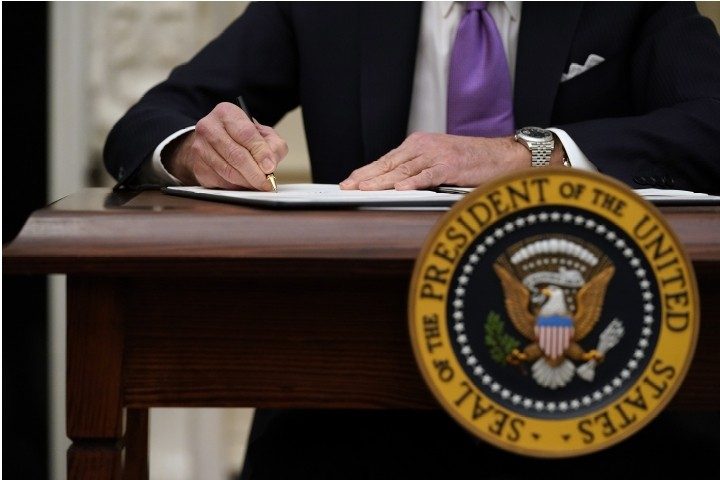
On day one as president, and as both promised and expected, Joe Biden issued a flurry of executive orders and actions. Among those actions was the president’s agreement that the United States accept the terms of the Paris Climate Agreement.
The full text of the statement from the White House reads:
I, Joseph R. Biden Jr., President of the United States of America, having seen and considered the Paris Agreement, done at Paris on December 12, 2015, do hereby accept the said Agreement and every article and clause thereof on behalf of the United States of America.
https://www.whitehouse.gov/briefing-room/statements-releases/2021/01/20/paris-climate-agreement/
Done at Washington this 20th day of January, 2021.
Celebrated by environmentalists and socialists, the Paris Agreement puts stringent international economic controls on the United States in the name of fighting man-made climate change. The result is unlikely to change the natural conditions of the environment, but it will likely contribute to economic malaise or worse for the citizens of the United States — and for others.
A key element of the Agreement is the move to centrally planned economies. The UN, in its summary of how the Agreement works, says: “Implementation of the Paris Agreement requires economic and social transformation, based on the best available science. The Paris Agreement works on a 5- year cycle of increasingly ambitious climate action carried out by countries. By 2020, countries submit their plans for climate action known as nationally determined contributions (NDCs).” [Emphasis in original.]
NDCs, meanwhile, are not optional. “In their NDCs, countries communicate actions they will take to reduce their Greenhouse Gas emissions in order to reach the goals of the Paris Agreement,” the UN says. “Countries also communicate in the NDCs actions they will take to build resilience to adapt to the impacts of rising temperatures.” The UN is careful to note that NDCs are mandatory.
Note the reference to a five-year cycle. Such plans are typical of socialist central-planning regimes, originating in the first five-year plan created by communist dictator Joseph Stalin in the Soviet Union. Such a plan is the “master plan” under which an economy is centrally managed in order to achieve goals set by government. It is a collective plan that subordinates individual goals and well-being to those goals set by bureaucrats and dictators.
By contrast, in a market economy, supply and demand for goods and services is set by the multitude of individual players in the market pursuing their own goals and interests and the price of those goods and services is derived from market-based transactions. Price signals from the market are instrumental in helping suppliers of goods and services understand how to invest resources in order to optimize production. This is the key economic feature of the market economy that results in the growth of prosperity across an entire economy.
In a planned economy, by contrast, production of goods and services is determined from the top without access to economic calculation made possibly by market activity. As a result, resources are improperly used, some items are built to large measures of oversupply and others are inadequately supplied, resulting in shortages. The total end result of a planned economy is one of scarcity, uncertainty, discomfort, and, eventually, collapse.
To put a finer point on the results of economic planning, recall that many millions of people have starved to death as the direct result of shortages artificially created by inherently faulty economic plans.
Article four of the Paris Agreement explicitly calls for a carbon-based version of economic planning. “Each Party shall communicate a nationally determined contribution every five years in accordance with decision 1/CP21 and any relevant decisions of the Conference of the Parties serving as the meeting of the Parties to this Agreement and be informed by the outcomes of the global stocktake referred to in Article 14,” reads article 9 of the Agreement.
In order to accomplish this, individual governments will be forced to legislate restrictions on economic activity, essentially usurping more power to determine how economic resources are used within a nation. This will run downhill to the average citizen. For example, the goal is to limit carbon emissions, and that will mean limiting combustion based on fossil fuels. Now think of all the things that run on fossil fuels. Government planning and legislation based on such planning will take away or make onerous the individual’s ability to use fossil-fuel powered combustion devices.
Ultimately, for example, you may want or need to drive a car powered by an internal combustion engine. But, because of the new need to comply with the Paris Accord, you may no longer be able to afford to purchase fuel, or even to purchase the car. In fact, such cars may completely disappear.
Your individual menu of possible options for transportation will be circumscribed by economic planners beholden to the UN Climate Agreement.
This will not effect the developing world, as the provisions of the Agreement are designed to punish developed nations (e.g., the United States) first.
According to the Agreement, “Developed country Parties should continue taking the lead by undertaking economy-wide absolute emission reduction targets. Developing country Parties should continue enhancing their mitigation efforts, and are encouraged to move over time towards economy-wide emission reduction or limitation targets in the light of different national circumstances.”
Meanwhile, developed nations will “help” the developing nations. “Support shall be provided to developing country Parties for the implementation of this Article, in accordance with Articles 9, 10 and 11, recognizing that enhanced support for developing country Parties will allow for higher ambition in their actions.”
Article 10 explains further: “Developed country Parties shall provide financial resources to assist developing country Parties with respect to both mitigation and adaptation in continuation of their existing obligations under the Convention.”
Under these terms, U.S. taxpayers will likely end up sending billions of dollars to developing countries such as India and China. In its NDC document, for example, India states that “at least USD 2.5 trillion (at 2014-15 prices) will be required for meeting India’s climate change actions between now and 2030.”
Even if the United States doesn’t fund the developing nations, the Agreement still gives those developing nations the edge as developed countries will have to clamp down on economic activity and developing countries won’t.
Ballotopedia, in its “Fact Check: China, India, and the Paris Climate Agreement,” notes of China that one of its goals to achieve by 2030 is “to reach peak CO2 emissions.” Of both India and China, former EPA Administrator Scott Pruitt, who is also the former Attorney General of Oklahoma, told Fox News that under the Paris Climate Agreement, “India didn’t have to take any steps in the agreement to reduce [carbon dioxide] emissions until they received $2.5 trillion in aid” Continuing, Pruitt said. “China didn’t have to take any steps until the year 2030.”
Following the Biden administration’s embrace of the Paris Agreement, Senator Ted Cruz warned that it would lead to economic hardship for Americans.
“By rejoining the Paris Climate Agreement, President Biden indicates he’s more interested in the views of the citizens of Paris than in the jobs of the citizens of Pittsburgh,” Senator Cruz said on Twitter. “This agreement will do little to affect the climate and will harm the livelihoods of Americans.”
Biden’s signature does not mean the climate agreement has the force of law. For that, it will need Senate ratification. Immediately following Biden’s action accepting the Paris Agreement, Senator Steve Daines (R-Montana) submitted a resolution calling for the administration to submit the measure to the Senate as required by the Constitution. According to Reuters, “The resolution was backed by five other Republicans — John Barrasso, Jerry Moran, Roger Marshall, Cynthia Lummis and Mike Crapo.”
Article II, Section 2 of the U.S. Constitution provides that the president has the power “by and with the Advice and Consent of the Senate, to make Treaties, provided two thirds of the Senators present concur.”
Commenting on the Biden action, Senator Daines warned of the damage it would cause. “Rejoining this agreement places our country at a competitive disadvantage and will lead to higher energy prices for Montana families and job loss in a time when rural economies are devastated, all for minimal benefit. At the very least, I urge President Biden to do what the Obama administration refused to do and submit the Paris Agreement to the Senate for consideration as required under the Constitution.”



